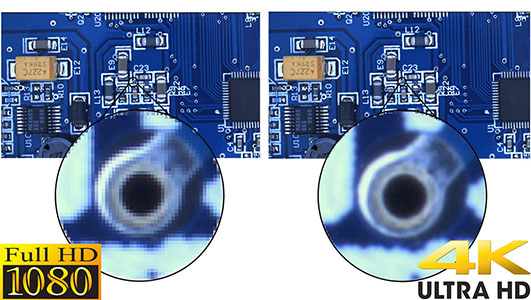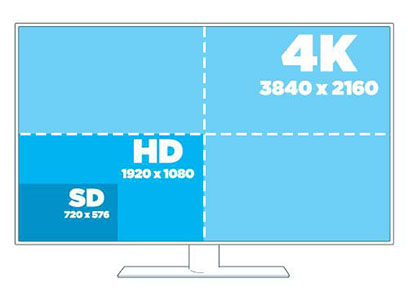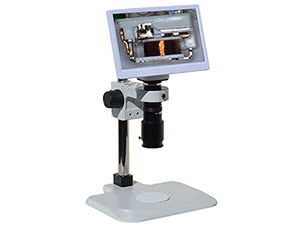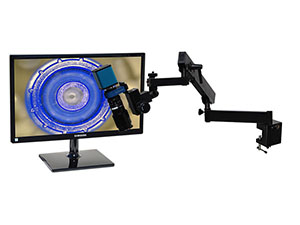If you’re part of the film industry or have recently been shopping for a new TV, you may have come across the HD 1080p vs 4K Ultra HD resolution debate. Generally speaking, new technology is better than older technology because it improves on technology that is already established. By that logic, if given the opportunity, you should always choose 4K Ultra HD over HD 1080p, right? Well, it depends.
What about for live inspections and image capture on digital microscope cameras connected to monitor displays: should you choose a 4K microscope camera over a HD 1080p camera? The answer depends on what your application requires.
What’s the Difference Between HD and 4K Resolution?
HD 1080p resolution, or Full HD 1080p, refers to the 16:9 ratio of 1920 (horizontal) x 1080 (vertical) pixel count. On a HD 1080p monitor, this translates to how many pixels make up each side of the display, respectively.

4K Ultra HD resolution, a.k.a. Ultra HD or UHD, consists of 3840 horizontal by 2160 vertical pixel counts. A 4K image/video or monitor contains more than 8 million pixels compared to the 2 million pixels that make up an HD 1080p medium or monitor; that’s four times the pixel count and resolution! The larger pixel count pays off in image quality because it allows for better rendering of finer details.

To help you visualize better, compare the size of an HD 1080p image when displayed on a monitor that can display 4K imaging. One HD 1080p image has a fourth of the amount of pixels than a 4K image, so four HD 1080p images would make up one 4K Ultra HD image.
The Pros and Cons of 4K Resolution Digital Microscope Camera
Retaining Image Quality even when Downscaled to HD 1080p
In addition to having better image quality, a 4K Ultra HD digital microscope camera will allow you to downscale saved media from 4K Ultra HD resolution to HD 1080p or lower formats while retaining sharpness. 4K images and videos can be cropped, zoomed in, and reframed without any loss in image quality to create backwards compatibility on platforms requiring HD 1080p format. Doing so can even mimic the effect of a second camera that pans closer or from a different angle.

If you attempt to zoom in on an HD 1080p medium, the image may appear blown up and blurry. Because 4K captures four times the amount of information, it has a larger sample of pixels to work with in order downsample into HD 1080p format without losing HD resolution.
Best for Live Inspection on Larger Monitor Size
4K Ultra HD digital microscope cameras work best when they are directly connected to a large 4K monitor via HDMI output. The larger the display size, the clearer you’ll see the image quality from 4K’s higher pixel count. Because most of our 4K microscope cameras offer integrated measurement software and SD card, you’ll be able to fully operate the system without PC connection.
If you still prefer to have the 4K camera directly connected to the PC for operation, note that while you can still capture media in 4K format, you will not have the full advantages of a 4K monitor’s ability to display the full pixel counts.
Higher Pixel Count = Larger File Size
Saving 4K Ultra HD media results in larger file sizes than HD 1080p media, so you’ll hit the limit on your memory card storage faster, and consequently, save a lot less 4K media files. Additionally, 4K images and videos will require more processing power to edit or playback on your computer. This is something to keep in mind, especially if you plan to do post-production editing with the 4K images and videos, to ensure your computer is powerful enough to handle these high resolution files without faltering in performance.
Deciding On Digital Microscope Resolution
Choosing a higher resolution digital microscope camera that can produce 4K Ultra HD media inevitably means it will have a higher price tag than an HD 1080p camera. If you have the budget for a 4K camera, then also consider the following questions:
- Is the main focus of your application live inspection?
- Do you intend to use the microscope as standalone unit (connected to monitor via HDMI port, and setting controlled with a mouse)?
- Will your workspace be able to accommodate for a larger monitor to benefit from 4K media’s higher pixel count?
If you have answered yes to all of the above questions, then a 4K Ultra HD digital microscope may be the right option for your needs.


HD 1080p is still Relevant
If you prefer PC connection, we recommend going with a Full HD 1080p digital microscopes instead, since you lose out on the full benefits of a 4K camera when it is not connected to a 4K Ultra HD monitor display. Although 4K Ultra HD is becoming more popular, it is still a relatively new format that is not quite standard yet. HD 1080p media will remain the most common resolution format for the foreseeable future, especially since it is harder to discern with the human eye the difference between 4K and HD 1080p image quality on smaller screens.
If your budget is limited, your application’s main focus is not live inspection, or you may need to share the media files with colleagues that don’t have the equipment to view in 4K UHD, a HD 1080p digital microscope camera will still work great for producing high quality media and live imaging.
Our HD800 HD 1080p digital microscopes are great options to consider, offering a wide field of view range and different stand configurations to accommodate for a variety of applications. The HD807 and HD801 are great low magnification options often used for PCB inspection and rework, while our HD806 system is specifically designed for higher magnification, close-up inspections.
Both our HD 1080p and 4K Ultra HD microscopes are available in manual focus, auto focus, USB output, Wi-Fi connection, and more. Contact us today for assistance with choosing a HD 1080p or 4K Ultra HD digital microscope for your application.
